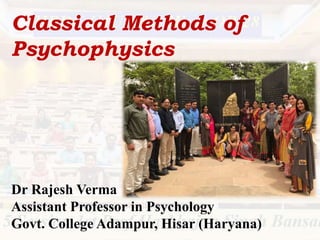
Classical Methods of Psychophysics Explained
- 1. Classical Methods of Psychophysics Dr Rajesh Verma Assistant Professor in Psychology Govt. College Adampur, Hisar (Haryana)
- 2. Methods of Psychophysics Fechner developed three tools to measure the relationship between intensity of stimulus and subsequent perception. These tools are called classical methods of psychophysics and employed to measure the stimulus threshold. The threshold has been defined as the stimulus value which is perceptible in 50% of the trials. The methods are used to ascertain the AL and DL of the stimulus (Gescheider, 1997, p-45).
- 3. Methods of Psychophysics The three methods are: - (i) Methods of Constant stimuli (ii) Method of Limits (iii) Method of Adjustment or Average Error
- 4. (i) Methods of Constant stimuli – In this method a set of stimuli of which some are above the threshold and some are below the threshold are used repeatedly (Gescheider recommends of five and nine different values) during the procedure. For example a subject is made to hear a base sound of 60 db. Then individual may be presented with five different levels of sounds (40 db, 80 db, 70 db, 30 db, 50 db) in random order with equal increment.
- 5. From the recorded responses the percentage of correct responses are calculated and plotted on a graph. The values of stimulus intensity are plotted on the X axis while the percentage of correct responses on Y axis. A line joining the points will be drawn and subsequently AL is calculated from the graph. The method is use to detect the differential threshold of JND.
- 6. (ii) Method of Limits – It means determining the detection limit of a stimulus. In this method both ascending or descending series of stimuli can be used. - Ascending Series means the presentation of stimulus should start with low intensity and gradually increasing with small equal increments till it is detected 50% of total responses.
- 7. - Descending Series means the presentation of stimulus should start with high intensity and gradually decreasing the stimulus value in small equal increments till it’s detection is perceived only in 50% of responses or detection is negated in 50% of responses. This method is generally used in audiometry (measurement of hearing) (Gescheider, 1997, p-55).
- 8. In this method 3 variation techniques are used (i) Up-&-down or Staircase – It is used to explore the transition points (Points where subject reverses her/his response). The average of transition points is said be as threshold. Graph Courtesy: Manuel Kuehner (www.Bedienhaptik.de) [CC BY-SA (https://creativecommons.org/licenses/by-sa/4.0)]
- 9. (ii) Threshold Tracking – First used by Bekesy in 1947. In this variation technique the variation in the intensity of stimulus is regulated by subject. As long as subject keeps the button pressed the stimulus will gradually decreases and as long as the button is released the intensity of stimulus will increase. The experiment can be started either with pressed or released state of button.
- 10. If started with pressed state then stimulus will gradually decrease till it reaches a point of disappearance. At this point the subject will release the button and stimulus will start to increase in its intensity till the point where it becomes detectable. Again at this point the button will be depressed and so on (Gescheider, 1997, p-60).
- 11. (iii) Forced Choice – First used by Blackwell in 1953 (Vision) and Jones in 1956 (Taste and Smell). It can be Temporal forced choice and Spatial forced choice. (a) Temporal Forced Choice – In temporal forced choice the subject is presented with a set of 4 observations in a sequence. The subject is required to tell which observation contains the stimulus.
- 12. (b) Spatial Forced Choice – While in spatial forced choice the information is presented to the subject simultaneously. Usually, the subject is presented with 4 quadrants out of which one quadrant contains stimulus. Two successive correct responses is taken as threshold of the stimulus (Gescheider, 1997, p-62).
- 13. (iv) Method of Adjustment – Also known as method of average error. This method is basically used for assessing the JND or Differential Threshold but also can be employed for AL. In this method the subject controls the intensity of stimulus. Initially the stimulus is set to a very low or very high intensity, the subject varies the intensity of stimulus until it becomes perceptible or disappears completely
- 14. The mean of settings suggested by the subject for perception or disappearance is take as AL. While assessing the DL the subject is asked to adjust the intensity of stimulus until it becomes differentiable. The mean of all stimulus intensities set by the subject is designated as JND or Differential threshold.
- 15. Use of Classical Methods These methods are used to measure 1. Absolute threshold or Absolute Limen (AL) or Detection Threshold – The threshold of the intensity of the stimulus required to perceive it. 2. Differential Threshold or Differential Limen (DL) or JND – The minimum value required to differentiate between two stimuli.
- 16. References: 1. Gescheider, G. A. (1997). Psychophysics: The Fundamentals. Psychology Press. 2. Bruce. V., Green, P. R. & Georgeson, M. A. (1996). Visual perception (3rd ed.). Psychology Press. 3. https://www.britannica.com/science/Webers-law. 4. https://en.wikipedia.org/wiki/Psychophysics. 5. https://www.britannica.com/science/ psychophysics.
- 17. Next Discussion Definition and Meaning of Learning
- 18. Meet You Soon With Next Video vermasujit@yahoo.com Thanks
